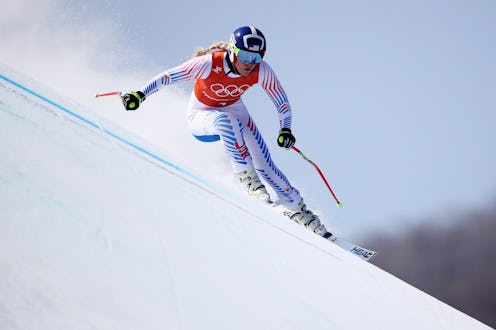
If you've been tuning into Olympic downhill skiing, you may have noticed something a little funky about the athletes' poles. Instead of the straight, picturesque sticks featured in kitschy ski decorations, Olympic downhill ski poles are often bent. The reason why can be explained by simple science.
If you think about the range of motions that downhill skiers engage in, you'll quickly come across the tuck. That would be when skiers fold into themselves, often in order to go faster. This is where bent ski poles come in. When a skier's poles are straight, they run the risk of flailing around, or worse — slowing the skier down.
When it comes to bent ski poles, it's really all about aerodynamics. Skiers want to go as fast as they possibly can in downhill events, and having folded poles allows skiers to match the shape of their poles to the shape of their bodies. It may seem like a nominal difference, since the poles are already so thin, as is, and the skiers are already going so fast. But the winners and losers in downhill skiing are often determined by fractions of a second.
Like competitive swimming, for example, absolutely every moment counts. A straight pole and a bent pole, in theory, could be the difference between a gold medal and not winning any medals at all.
The downhill ski event is one of five alpine skiing events at the Winter Olympics. It is also one one of the most dangerous. When they compete in the event, athletes can reach speeds of up to 95 miles per hour — well over the speed limits on American highways. NPR reports that the highest downhill skiing speed every recorded was 96.6 miles per hour.
The women's downhill final during the 2018 PyeongChang Olympic Games is a perfect example of just how important speed can be. The three winning times in the competition were all in the 1:39 range. The difference between Lindsey Vonn's bronze medal and Sofia Goggia's gold medal? Just 47 hundredths of a second. It's really that close.
While the time difference may seem nominal to an outsider, to a competitive downhill skier, it means everything. When it began to appear on Tuesday evening that Lindsey Vonn would likely walk away with the bronze medal, the decorated skier poured tears in a post-race interview with NBC.
"It's sad," she said. "This is my last downhill. I wish I could keep going, you know? I have so much fun. I love what I do. My body just can't — probably can't — take another four years," she said. When a person is hurdling themselves down a mountainside at freeway rates, that explanation makes a lot of sense.
Downhill skiers often face tremendous pressure to complete, arguably, superhuman tasks. The very notion of sliding down a mountain evokes thoughts of all the dangers associated with engaging in such an activity.
David Currier, a former Olympic downhill racer, told NPR in an interview in 2006 that almost every course includes a portion wherein racers are gliding at rates of about 85 miles per hour. In a way, that also implies that, if most racers are going to hit 85 miles per hour around the same part of the course, then skiers actually begin competing at 85 miles per hour, not the starting line. That's really fast.
One thing is definitely true, however: when it comes to downhill skiing, speed is the name of the game. And if Olympic medaling downhill skiers like Vonn believe that an altered pole shape makes a difference, it's probably best to take their advice.